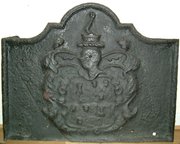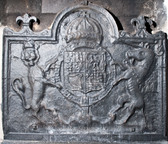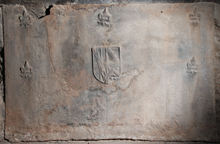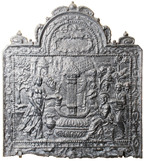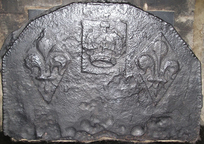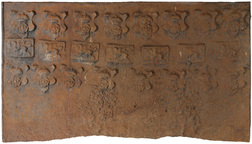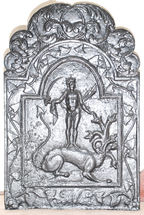-
16
Description: Arched rectangular shape cut away with symmetrical concave curves; ovolo moulding (top and sides); shield, helmet, crest and mantling of the family of Baker, of Mayfield, quartered with Farnden, of Sedlescombe: Quarterly, 1st and 4th, Argent, a tower between three keys erect sable (Baker); 2nd and 3rd, Purpure, a chevron vairy Or and gules, between three leopards’ faces Or (Farnden). Crest (Baker): on a tower sable an arm embowed in mail holding in the hand a flint-stone proper.
Notes: A carved armorial on a plain, edged base board; John Baker (1644-1723) married Ruth, daughter and co-heiress of Peter Farnden, in 1663; she died in 1691, thereafter the arms of Baker quartered those of Farnden; the arms of Farnden had been granted in 1634. The armorial design has been inadequately pressed into the sand bed.
Copies of this fireback are known.
Arms: Baker, of Mayfield, quartering Farnden, of Sedlescombe
- Decoration tags:
- rectangular with canted top corners and round arch (shape)
- ovolo (edging)
- carved pattern panels
- armorial
Manufactured: in the early- to mid-18th century possibly at Heathfield Furnace in the Weald area of England.
Current location: Battle Museum of Local History, Battle, East Sussex, England.
- Attached to series:
- Personal armorial firebacks
- Ironmasters armorial series
-
205
Description: Canted rectangle; simulated rectangular chain link moulded border, with bead edging inside (top and sides); Tudor royal shield surrounded by circular inscription with fillet edging; above, an English royal crown.
Notes: The unconventionality of the motto may indicate a particular purpose, e.g. thanksgiving; the edging is not known on other firebacks. Bonhams sale, Chester, 8-9 September 2009, lot 567 (£1,776).
Inscription: VIVAT·REGIN··A·DIV·:·PA CE [Long live the Queen ... peace]
Arms: Tudor royal
- Decoration tags:
- rectangular with canted top corners (shape)
- complex, furniture-derived (edging)
- carved stamps
- heraldic
- armorial
- royal
Manufactured: in the late-16th century in England.
Current location: not known.
- Attached to series:
- Tudor royal armorial firebacks
-
1208
Description: Arched rectangular shape with a fleur-de-lys springing from each shoulder; cyma recta-moulded edging; quartered shield of the Stuart royal arms of England with surrounding Garter, surmounted by a crown and supported by a crowned lion and unicorn; indistinct motto cartouche along the bottom.
Notes: A poorly-modelled and much-worn fireback. The fleur extensions to the top of the edging are an unusual feature
Arms: English Stuart royal
- Decoration tags:
- rectangular with round arch (shape)
- cyma recta (edging)
- whole carved pattern
- heraldic
- armorial
- royal
Manufactured: in the 17th century in England.
Current location: Blackwell House, Bowness-on-Windermere, Cumbria, England.
- Attached to series:
- Stuart royal armorial firebacks
-
951
Description: Rectangular; central shield; fleur-de-lys stamp repeated three times across top and once on each side level with shield, all regularly spaced.
Notes: It is likely that the arms relate to the marriage, in 1541, of Christopher Sackville (c.1519-1559), son of John Sackville of Chiddingly, Sussex, and Constance Colepeper, daughter of Thomas Colepeper of Bedgebury, Kent, one of whose ancestors was the heiress, Elizabeth Hardreshull. The blazon: Sackville - quarterly or and gules, a bend vair; Colepeper - argent a bend engrailed gules; Hardreshull - argent a chevron sable between nine martlets gules, six and three. Christopher Sackville's brother, Sir Richard, owned Horsted Keynes furnace, which may have been where this fireback was cast. A candidate for the earliest English fireback with an example of personal arms.
Arms: Sackville impaling Colepeper and Hardreshall
- Decoration tags:
- rectangular (shape)
- none (edging)
- carved stamps
- heraldic
- armorial
Manufactured: in the mid-16th century possibly at Horsted Keynes Furnace in the Weald area of England.
Current location: in private hands, Horsted Keynes, West Sussex, England.
- Attached to series:
- Personal armorial firebacks
- Sackville firebacks
-
517
Description: Rectangular; ogee within broad fillet moulded edging; top centre, date between split initials, with small diamonds between date and initials and outside initials.
Inscription: T 1665 S
- Decoration tags:
- rectangular (shape)
- fillet and ogee (edging)
- text
Manufactured: in 1665 in the Weald area of England.
Current location: Penshurst Place, Penshurst, Kent, England.
- Attached to series:
- Date & initials firebacks
-
569
Description: Rectangular central panel with bead edging all round, pictorial scene of a landscape at the fore of which Jesus sits at a well with the woman of Samaria; above the panel is a bead-edged arch with a floral wreath; arched rectangular border with canted top corners and cavetto-moulded edging; repeated low-relief pattern of linked squares and diamonds; at the bottom, indistinct floral swirls; on top, a small crown with descending mirrored swirls.
Notes: The scene is from John 4. Mitford collection, Petworth House.
Manufactured: in the mid- to late-17th century possibly in the Siegerland area of Germany.
Current location: Petworth House, Petworth, West Sussex, England.
Museum number: NT/PET/M/61 (part of the National Trust museum group)
- Attached to series:
- 'Dutch' Miscellaneous Firebacks
- New Testament firebacks
-
1164
Description: Rectangular with 5-facetted arch; twisted rope edging; centre top, rectangular stamp, over-pressed, with crown above initials in bottom corners; diamond shaped stamp with fleur-de-lys repeated each side of crown, both over-pressed.
Notes: Notable for the large size of the fleur-de-lys stamp; this casting differs from another (no. 486) in the placement of the stamps. Formerly at Parsonage Farm, Steeple Bumpstead, Essex.
Inscription: E R
- Decoration tags:
- multi-facet arched (shape)
- rope (edging)
- simple stamps
- carved stamps
- heraldic
- royal
- text
- objects
Manufactured: in the mid- to late-16th century in the Weald area of England.
Current location: in private hands, Newmarket, Suffolk, England.
- Attached to series:
- Large diamond fleur series
- Fleur-de-lys firebacks
-
1260
Description: Rectangular shape; twisted rope edging (top and sides); from top: rose and crown within a shield stamped eight times horizontally; rectangular stamp with a griffin passant repeated seven times horizontally; rose and crown within a shield stamped eight times horizontally.
Notes: Five other firebacks bearing these stamps are known: two are in Hastings, and one, dated 1569, is at Hadlow Down, Sussex. The locations of the other two, formerly in Ipswich and Guildford, are not known. Two excrescences on the lower part of the fireback show where the iron was poured, displacing the sand in the mould. Woolley & Wallis auction, Salisbury, 4 Apr 2023, lot 46 (£1,400).
- Decoration tags:
- rectangular (shape)
- rope (edging)
- carved stamps
- heraldic
Manufactured: in the mid- to late-16th century in the Weald area of England.
Current location: not known.
- Attached to series:
- Griffin series
-
803
Description: Arched rectangular central panel, astragal and fillet edge, pictorial, Hercules, sword in hand, preparing to slay the Hydra; Arched rectangular border, fillet edge, ivy leaves and tendrils, monogram at bottom; swirled foliage on top.
Notes: The wooden pattern for this fireback (no. 927), formerly in the custody of William Hobday (d. 1883), last surviving ironworker at Ashburnham furnace, was given to the Sussex Archaeological Society by the Revd. J. Bickersteth. The fireback was previously at a house at Hooe, East Sussex.
Copies of this fireback are known.
Inscription: TAN
- Decoration tags:
- 'Dutch' (shape)
- fillet (edging)
- whole carved pattern
- pictorial
- mythological
- monogram
- text
- humans
Manufactured: in the 18th century at Ashburnham Furnace in the Weald area of England.
Current location: in private hands, Crawley, West Sussex, England.
Citation: Butterfield, W. R., 1916, 'Old Wealden Firebacks', The Connoisseur, 46, pp. 197-209.
Citation: Lloyd, N., 1925, 'Domestic Ironwork I', Architectural Review, 58, pp. 58-67.
Citation: Straker, E., 1931, Wealden Iron (London, Bell).
- Attached to series:
- TAN series
- British 'Dutch' style firebacks
